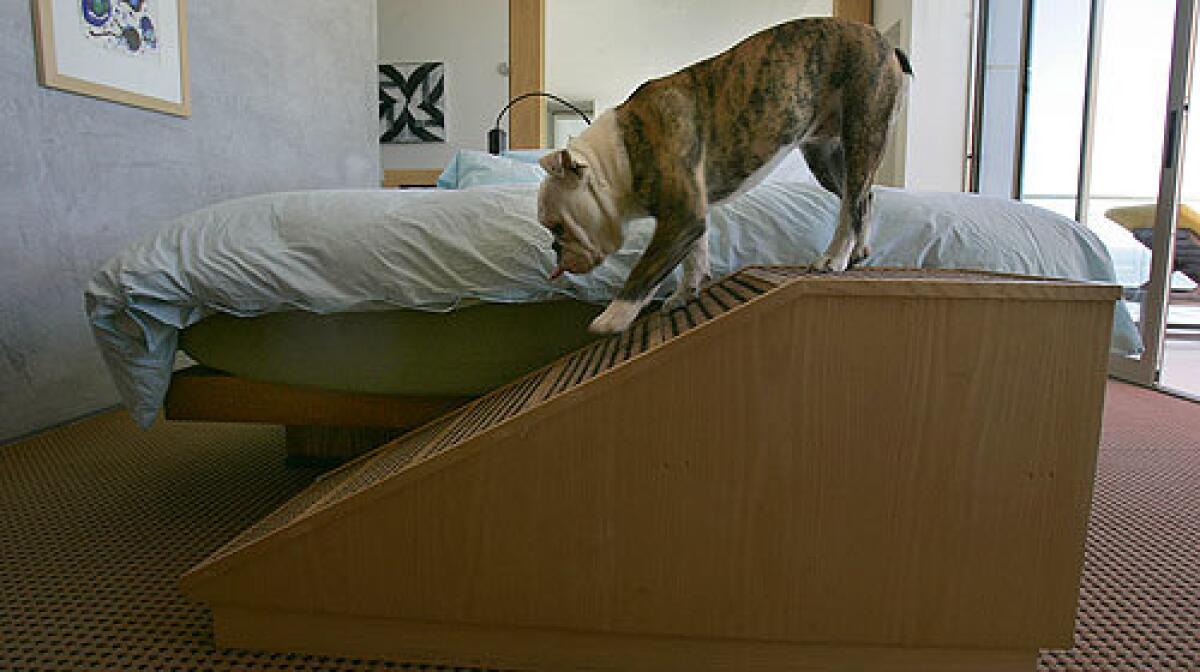How to build a dog ramp

MOST DOGS know the best bed in town is the one their humans sleep on. But what if a dog’s legs are too short or too old to make the mighty leap?
When the Home section profiled Katie and Charles Arnoldi in March, among the design elements in their Malibu house was a custom dog ramp. The couple had asked Venice cabinetmaker Tucker Strasser to design a ramp after their bulldog, Rosie, no longer could vault into bed with them.
After Rosie died, the Arnoldis adopted bulldog puppies Ruby and Bean.
“They figured out how to use Rosie’s ramp in about two seconds,” Katie Arnoldi says. “Now they enjoy full access to the bed, where we all sleep together.”
Strasser ( rtswood@verizon.net) will build a custom ramp for about $300 to $400, but he also agreed to share his design for do-it-yourselfers. Take away the short pedestal in the design shown here, and you’ll have a relatively easy structure composed of seven pieces of plywood -- all of which can be cut from a single sheet.
Strasser suggests using quality three-quarter-inch plywood, available at any lumberyard. Dimensions for the cuts are listed above; Strasser generally recommends a 16-inch-wide walking surface and a 16-inch-square landing at the top, large enough to accommodate most dogs.
Once the plywood has been cut, use 1 5/8 -inch drywall screws to hold the pieces together. Screw the back panel and hidden center support to the side pieces. Then attach the top landing, ramp and front cap. Strasser suggests pre-drilling holes and placing screws about every 8 inches. Once the piece is assembled, sand to soften the edges.
Strasser finished the Arnoldis’ ramp with leftovers from their bedroom carpet installation. He suggests gluing the carpet atop the ramp, then using 1-inch drywall screws to attach pine cross treads, which will give paws added traction. Six strips of pine, evenly spaced, should do the trick. Four screws per tread will help to keep the carpeting in place.
For better or worse, sleeping will never be the same.
WHAT YOU’LL NEED
Equipment:Drill, screwdriver. If lumber supplier won’t cut plywood to specifications below, make rough cuts at the store and use a saber saw to get exact measurements at home.
Materials:Three-quarter-inch plywood cut into seven pieces -- a 16-by-16-inch landing, a 16-by-36-inch ramp (edges beveled as needed), two 15 1/4 -by-14 1/2 -inch pieces (the back panel and the hidden center support), two 16-by-42-inch sides angle-cut to match the incline of the ramp, and a 3-by-14 1/2 -inch end cap. Three-eighths-inch-thick pine, cut into six strips (each about 14 inches long and three-quarters-inch wide). An 18-by-60-inch piece of carpeting. Carpet glue. Drywall screws (1 5/8 -inch and 1-inch).
More to Read
Sign up for our L.A. Times Plants newsletter
At the start of each month, get a roundup of upcoming plant-related activities and events in Southern California, along with links to tips and articles you may have missed.
You may occasionally receive promotional content from the Los Angeles Times.






